SUBARU advanced frontal airbag system
Your vehicle is equipped with a SUBARU advanced frontal airbag system that complies with the new advanced frontal airbag requirements in the amended Federal Motor Vehicle Safety Standard (FMVSS) No. 208.
The SUBARU advanced frontal airbag system automatically determines the deployment force of the driver’s SRS frontal airbag at the time of deployment as well as whether or not to activate the front passenger’s SRS frontal airbag and, if activated, the deployment force of the SRS frontal airbag at the time of deployment.
Your vehicle has warning labels on the driver’s and front passenger’s sun visors beginning with the phrase “EVEN WITH ADVANCED AIR BAGS” and a tag attached to the glove box lid beginning with the phrase “Even with Advanced Air Bags”. Make sure that you carefully read the instructions on the warning labels and tag.
Always wear your seatbelt. The SUBARU advanced frontal airbag system is a supplemental restraint system and must be used in combination with a seatbelt. All occupants should wear a seatbelt or be seated in an appropriate child restraint system.
The driver’s SRS frontal airbag is stowed in the center portion of the steering wheel.
The front passenger’s SRS frontal airbag is stowed near the top of the dashboard under an “SRS AIRBAG” mark.
In a moderate to severe frontal collision, the driver’s and front passenger’s SRS frontal airbags deploy and supplement the seatbelts by reducing the impact on the driver’s and front passenger’s head and chest.
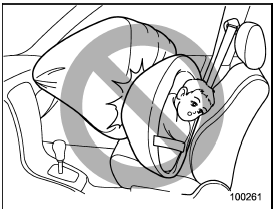
WARNING
NEVER INSTALL A REARWARD FACING CHILD SAFETY SEAT IN THE FRONT SEAT. DOING SO RISKS SERIOUS INJURY OR DEATH TO THE CHILD BY PLACING THE CHILD’S HEAD TOO CLOSE TO THE SRS AIRBAG.
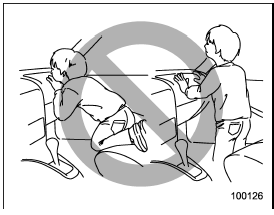
WARNING
Never allow a child to stand up, or to kneel on the front passenger’s seat.
The SRS airbag deploys with considerable force and can injure or even kill the child.
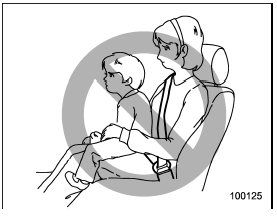
WARNING
Never hold a child on your lap or in your arms. The SRS airbag deploys with considerable force and can injure or even kill the child.
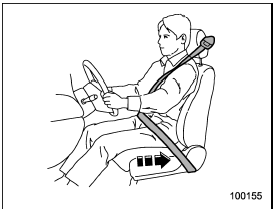
WARNING
The SRS airbag deploys with considerable speed and force. Occupants who are out of proper position when the SRS airbag deploys could suffer very serious injuries. Because the SRS airbag needs enough space for deployment, the driver should always sit upright and well back in the seat as far from the steering wheel as practical while still maintaining full vehicle control and the front passenger should move the seat as far back as possible and sit upright and well back in the seat.
It is also important to wear your seatbelt to help avoid injuries that can result when the SRS airbag contacts an occupant not in proper position such as one thrown toward the front of the vehicle during preaccident braking.
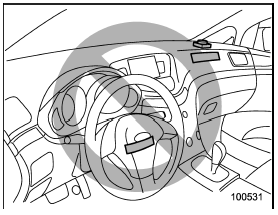
WARNING
Do not put any objects over the steering wheel pad and dashboard.
If the SRS frontal airbag deploys, these objects could interfere with its proper operation and could be propelled inside the vehicle, causing injury.
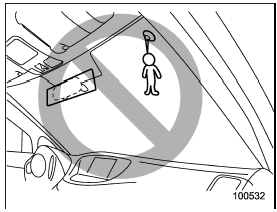
WARNING
Do not attach accessories to the windshield, or fit an extra-wide mirror over the rear view mirror. If the SRS airbag deploys, those objects could become projectiles that could seriously injure vehicle occupants.
▲ Driver’s SRS frontal airbag
dual stage inflator. The inflator operates in different ways depending on the severity of impact, backward-forward adjustment of the driver’s seat position and whether or not he/she is wearing the seatbelt.
The backward-forward adjustment of the driver’s seat position is monitored by the driver’s seat position sensor under the driver’s seat.
Whether or not the driver is wearing the seatbelt is monitored by the seatbelt buckle switch.
Observe the following precautions. Failure to do so may cause the seatbelt buckle switch and/or the seat position sensor to malfunction, preventing the SUBARU advanced frontal airbag system from functioning correctly or causing the system to fail.
• Do not place articles/metal objects or install any accessory other than a genuine SUBARU accessory under the driver’s seat. Do not allow the rear seat occupant to kick the driver’s seat or push up its bottom surface with his/her feet.
• Do not place a magnet near the seatbelt buckle or under the driver’s seat.
If the seatbelt buckle switch and/or the driver’s seat position sensor have failed, the SRS airbag system warning light will illuminate. Although the driver’s SRS frontal airbag can deploy regardless of the backward-forward adjustment of the driver’s seat position even when the warning light illuminates, have the system inspected by your SUBARU dealer immediately if the SRS airbag system warning light illuminates.
NOTE
The driver’s SRS side airbag, SRS curtain airbag and seatbelt pretensioner are not controlled by the SUBARU advanced frontal airbag system.
▲ Front passenger’s SRS frontal airbag
The front passenger’s SRS frontal airbag uses a dual stage inflator. The inflator operates in different ways depending on the severity of impact.
The total load on the seat is monitored by the occupant detection system’s weight sensor located under the seat.
The system has another sensor that monitors the tension of the front passenger seatbelt. Using the total seat load and seatbelt tension data from the sensors, the occupant detection system determines whether the front passenger’s SRS frontal airbag should or should not be inflated.
The occupant detection system may not inflate the front passenger’s SRS frontal airbag even when the driver’s SRS frontal airbag deploys. This is normal.
Observe the following precautions. Failure to do so may prevent the SUBARU advanced frontal airbag system from functioning correctly or cause the system to fail.
• Do not apply any strong impact to the front passenger’s seat such as by kicking.
• Do not spill liquid on the front passenger’s seat. If liquid is spilled, wipe it off immediately.
• Do not remove or disassemble the front passenger’s seat.
• Do not install any accessory (such as an audio amplifier) other than a genuine SUBARU accessory under the front passenger’s seat.
• Do not place anything (shoes, umbrella, etc.) under the front passenger’s seat.
• The front passenger’s seat must not be used with the head restraint removed.
• Do not leave any article including a child restraint system on the front passenger’s seat or the seatbelt tongue and buckle engaged when you leave your vehicle.
• Do not place a magnet near the seatbelt buckle and the seatbelt retractor.
If the seatbelt buckle switch and/or front passenger’s occupant detection system have failed, the SRS airbag system warning light will illuminate. Have the system inspected by your SUBARU dealer immediately if the SRS airbag system warning light illuminates.
If your vehicle has sustained impact, this may affect the proper function of the SUBARU advanced frontal airbag system.
Have your vehicle inspected at your SUBARU dealer.
NOTE
The front passenger’s SRS side airbag, SRS curtain airbag and seatbelt pretensioner are not controlled by the SUBARU advanced frontal airbag system.
▲ Passenger’s frontal airbag ON and OFF indicators

The front passenger’s frontal airbag ON and OFF indicators show you the status of the front passenger’s SRS frontal airbag.
The indicators are located in the center portion of the instrument panel.
When the ignition switch is turned to the “ON” position, both the ON and OFF indicators illuminate for 6 seconds during which time the system is checked. Following the system check, both indicators turn off for 2 seconds. After that, one of the indicators illuminates depending on the status of the front passenger’s SRS frontal airbag determined by the SUBARU advanced frontal airbag system monitoring.
If the front passenger’s SRS frontal airbag is activated, the passenger’s frontal airbag ON indicator will illuminate while the OFF indicator will remain off.
If the front passenger’s SRS frontal airbag is deactivated, the passenger’s frontal airbag ON indicator will remain off while the OFF indicator will illuminate.
With the ignition switch turned to the “ON” position, if both the ON and OFF indicators simultaneously remain illuminated or off even after the system check period, the system is malfunctioning. Contact your SUBARU dealer immediately for an inspection.
▲ Conditions in which front passenger’s SRS frontal airbag is not activated
The front passenger’s SRS frontal airbag will not be activated when any of the following conditions are met regarding the front passenger’s seat.
• The seat is empty.
• The seat is equipped with a rearward
facing child restraint system and an infant
is restrained with it. (See WARNING that
follows.)
• The seat is equipped with a forward
facing child restraint system and a small
child is restrained with it. (See WARNING
that follows.)
• The seat is equipped with a booster
seat and a small child is in the booster
seat. (See WARNING that follows.)
• The seat is relieved of the occupant
load for a time exceeding the predetermined
monitoring time period.
• The seat is occupied by a child who has outgrown a child restraint system (See WARNING that follows.) or by a small adult.
• The front passenger’s occupant detection system is malfunctioning.
WARNING
NEVER INSTALL A REARWARD FACING CHILD SEAT IN THE FRONT PASSENGER’S SEAT EVEN IF THE FRONT PASSENGER’S SRS FRONTAL AIRBAG IS DEACTIVATED. Be sure to install it in one of the rear seating positions recommended in this Owner’s Manual in a correct manner. Also, it is strongly recommended that any forward facing child seat or booster seat be installed in one of the rear seating positions recommended in this Owner’s Manual, and that even children who have outgrown a child restraint system be also seated in a REAR seat. This is because children sitting in the front passenger’s seat may be killed or severely injured should the front passenger’s SRS frontal airbag deploy. REAR seats are the safest place for children.
When the front passenger’s seat is occupied by a child, observe the following precautions. Failure to do so may increase the load on the front passenger’s seat, activating the front passenger’s SRS frontal airbag even though that seat is occupied by a child.
• Do not place any article on the seat other than the child occupant and a child restraint system.
• Do not place more than one child on the seat.
• Do not install any accessory such as a table or TV onto the seatback.
• Do not store a heavy load in the seatback pocket.
• Do not allow the rear/second-row seat occupant to place his/her hands or legs on the front passenger’s seatback, or allow him/her to pull the seatback.
▲ If the front passenger’s frontal airbag ON indicator illuminates and the OFF indicator turns off even when an infant or a small child is in a child restraint system (including booster seat)
Turn the ignition switch to the “LOCK” position if the front passenger’s frontal airbag ON indicator illuminates and the OFF indicator turns off even when an infant or a small child is in a child restraint system (including booster seat). Remove the child restraint system from the seat. By referring to the child restraint manufacturer’s recommendations as well as the child restraint system installation procedures in the “Child restraint systems” F1- 29 section in this chapter, correctly install the child restraint system. Turn the ignition switch to the “ON” position and make sure that the front passenger’s frontal airbag ON indicator turns off and the OFF indicator illuminates.
If the ON indicator still remains illuminated while the OFF indicator turns off, take the following actions.
• Ensure that no article is placed on the seat other than the child restraint system and the child occupant.
• Ensure that there is no article left in the seatback pocket.
If the ON indicator still remains illuminated while the OFF indicator turns off after taking relevant corrective actions described above, relocate the child restraint system to one of the rear seating positions recommended in this Owner’s Manual and immediately contact your SUBARU dealer for an inspection.
NOTE
When a child who has outgrown a child restraint system or a small adult is seated in the front passenger’s seat, the SUBARU advanced frontal airbag system may or may not activate the front passenger’s SRS frontal airbag depending on the occupant’s seating posture. If the front passenger’s SRS frontal airbag is activated (the ON indicator remains illuminated while the OFF indicator turns off), take the following actions.
• Ensure that no article is placed on the seat other than the occupant.
• Ensure that there is no article left in the seatback pocket.
If the ON indicator still remains illuminated while the OFF indicator turns off despite the fact that the actions noted above have been taken, seat the child/ small adult in the rear seat and immediately contact your SUBARU dealer for an inspection. Even if the system has passed the dealer inspection, it is recommended that on subsequent trips the child/small adult always take the rear seat.
Children who have outgrown a child restraint system should always wear the seatbelt irrespective of whether the airbag is deactivated or activated.
▲ Conditions in which front passenger’s SRS frontal airbag is activated
The front passenger’s SRS frontal airbag will be activated for deployment upon impact when any of the following conditions is met regarding the front passenger’s seat.
• When the seat is occupied by an adult.
• When a heavy article is placed on the seat.
When the front passenger’s seat is occupied by an adult, observe the following precautions. Failure to do so may lessen the load on the front passenger’s seat, deactivating the front passenger’s SRS frontal airbag despite the fact that the seat is occupied by an adult.
• Do not allow the second-row seat occupant to lift the front passenger’s seat cushion using his/her feet.
• Do not place any article under the front passenger’s seat, or squeeze any article from behind and under the seat. This may lift the seat cushion.
• Do not squeeze any article between the front passenger’s seat and side trim/ pillar, door or center console box. This may lift the seat cushion.
▲ If the passenger’s frontal airbag OFF indicator illuminates and the ON indicator turns off even when the front passenger’s seat is occupied by an adult
This can be caused by the adult incorrectly sitting in the front passenger’s seat.
Turn the ignition switch to the “LOCK” position. Ask the front passenger to set the seatback to the upright position, sit up straight in the center of the seat cushion, correctly fasten the seatbelt, position his/ her legs out forward, and adjust the seat to the rearmost position. Turn the ignition switch to the “ON” position. If the OFF indicator remains illuminated while the ON indicator remains off, take the following actions.
• Turn the ignition switch to the “LOCK” position.
• Ensure that there are no articles, books, shoes, or other objects trapped under the seat, at the rear of the seat, or on the side of the seat.
• Next, turn the ignition switch to the “ON” position and wait 6 seconds to allow the system to complete self-checking.
Following the system check, both indicators turn off for 2 seconds. Now, the ON indicator should illuminate while the OFF indicator remains off.
If the OFF indicator still remains illuminated while the ON indicator remains off, ask the occupant to move to the rear seat and immediately contact your SUBARU dealer for an inspection.
▲ How to contact the vehicle manufacturer concerning modifications for persons with disabilities that may affect the advanced airbag system (U.S. only)
Changing or moving any parts of the front seats, seatbelts, front bumper, front side frame, instrument panel, combination meter, steering wheel, steering column, tire, suspension or floor panel can affect the operation of the SUBARU advanced airbag system. If you have any questions, you may contact the following SUBARU distributors.
<Continental U.S., Alaska and the District
of Columbia>
Subaru of America, Inc.
Customer Dealer Services Department
P.O. Box 6000
Cherry Hill, NJ 08034-6000
1-800-SUBARU3 (1-800-782-2783)
<Hawaii>
Servco Subaru Inc., dba Subaru Hawaii
2850 Pukoloa Street, Suite 202, Honolulu,
HI 96819
808-839-2273
<Guam>
Shen’s Corporation dba Prestige Automobile
491, East Marine Drive, Route 1 Dededo,
Guam
671-633-2698
<Puerto Rico>
Trebol Motors
P.O. Box 11204, San Juan, Puerto Rico
00910
787-793-2828
There are currently no SUBARU distributors in any other U.S. territories. If you are in such an area, please contact the SUBARU distributor or dealer from which you bought your vehicle.
▲ Operation

The SRS airbag can function only when the ignition switch is in the “ON” position.
The SUBARU advanced frontal airbag system is designed to determine the activation or deactivation condition of the front passenger’s SRS frontal airbag depending on the total load on the front passenger’s seat monitored by the front passenger’s occupant detection system weight sensor. For this reason, only the driver’s SRS frontal airbag may deploy in the event of a collision, but this does not mean failure of the system.
If the front sub sensors located on both sides of the radiator panel and the impact sensors in the airbag control module detect a predetermined amount of force during a frontal collision, the control module sends signals to the airbag module(s) (only driver’s module or both driver’s and front passenger’s modules) instructing the module(s) to inflate the SRS frontal airbag(s). The driver’s and front passenger’s SRS frontal airbags use dual stage inflators. The two inflators of each airbag are triggered either sequentially or simultaneously, depending on the severity of impact, backward-forward adjustment of the driver’s seat position and fastening/unfastening of the seatbelt in the case of the driver’s SRS frontal airbag and depending on the severity of impact and the total load on the seat in the case of the front passenger’s SRS frontal airbag.
After deployment, the SRS airbag immediately starts to deflate so that the driver’s vision is not obstructed. The time required from detecting impact to the deflation of the SRS airbag after deployment is shorter than the blink of an eye.
When only the driver’s SRS frontal airbag deploys and both the driver’s and front passenger’s SRS frontal airbags deploy, the driver’s and front passenger’s seatbelt pretensioners operate at the same time.
Although it is highly unlikely that the SRS airbag would activate in a non-accident situation, should it occur, the SRS airbag will deflate quickly, not obscuring vision and will not interfere with the driver’s ability to maintain control of the vehicle.
When the SRS airbag deploys, a sudden, fairly loud inflation noise will be heard and some smoke will be released. These occurrences are a normal result of the deployment. This smoke does not indicate a fire in the vehicle.
CAUTION
Do not touch the SRS airbag system components around the steering wheel and dashboard with bare hands right after deployment. Doing so can cause burns because the components can be very hot as a result of deployment.
The driver’s SRS frontal airbag and front passenger’s SRS frontal airbag are designed to deploy in the event of an accident involving a moderate to severe frontal collision. They are not designed to deploy in most lesser frontal impacts because the necessary protection can be achieved by the seatbelt alone. Also, they are not designed to deploy in most side or rear impacts or in most rollover accidents because deployment of only the driver’s SRS frontal airbag or both driver’s and front passenger’s SRS frontal airbags would not help the occupant in those situations. The driver’s and front passenger’s SRS frontal airbags are designed to function on a one-time-only basis.
SRS airbag deployment depends on the level of force experienced in the passenger compartment during a collision. That level differs from one type of collision to another, and it may have no bearing on the visible damage done to the vehicle itself.
▲ Examples of accidents in which the driver’s/driver’s and front passenger’s SRS frontal airbag(s) will most likely deploy
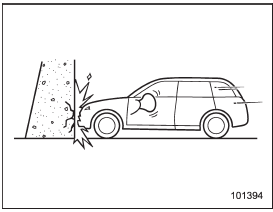
A head-on collision against a thick concrete wall at a vehicle speed of 12 to 19 mph (20 to 30 km/h) or higher activates only the driver’s SRS frontal airbag or both driver’s and front passenger’s SRS frontal airbags. The airbag(s) will also be activated when the vehicle is exposed to a frontal impact similar in fashion and magnitude to the collision described above.
▲ Examples of the types of accidents in which it is possible that the driver’s/driver’s and front passenger’s SRS frontal airbag(s) will deploy
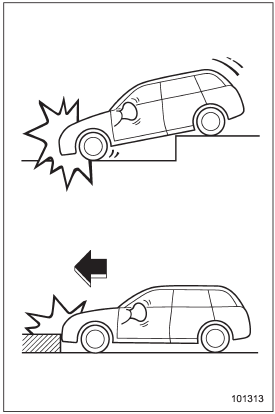
Only the driver’s SRS frontal airbag or both driver’s and front passenger’s SRS frontal airbags may be activated when the vehicle sustains a hard impact in the undercarriage area from the road surface (such as when the vehicle plunges into a deep ditch, is severely impacted or knocked hard against an obstacle on the road such as a curb).
▲ Examples of the types of accidents in which deployment of the driver’s/ driver’s and front passenger’s SRS frontal airbag(s) is unlikely to occur
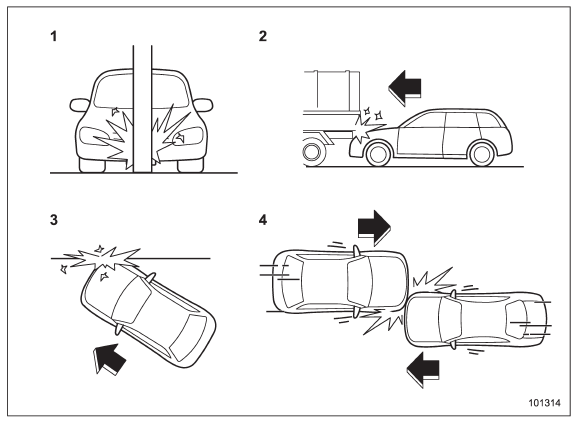
1) The vehicle strikes an object, such as a telephone pole or sign pole.
2) The vehicle slides under the load bed of a truck.
3) The vehicle sustains an oblique offset frontal impact.
4) The vehicle sustains an offset frontal collision.
There are many types of collisions which might not necessarily require deployment of driver’s/driver’s and front passenger’s SRS frontal airbag(s). In the event of accidents like those illustrated, the driver’s/ driver’s and front passenger’s SRS frontal airbag(s) may not deploy depending on the level of accident forces involved.
▲ Examples of the types of accidents in which the driver’s/driver’s and front passenger’s SRS frontal airbag(s) is/are not designed to deploy in most cases
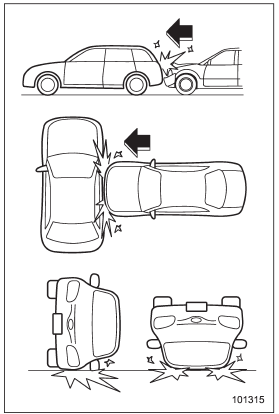
The driver’s and front passenger’s SRS frontal airbags are not designed to deploy in most cases if the vehicle is struck from the side or from behind, or if it rolls onto its side or roof, or if it is involved in a lowspeed frontal collision.

In an accident where the vehicle is impacted more than once, the driver’s and/or front passenger’s SRS frontal airbag(s) will deploy only once on the first impact.
Example: In the case of a double collision, first with another vehicle, then against a concrete wall in immediate succession, once either or both of the driver’s and front passenger’s SRS frontal airbags is/are activated on the first impact, it/they will not be activated on the second impact.
